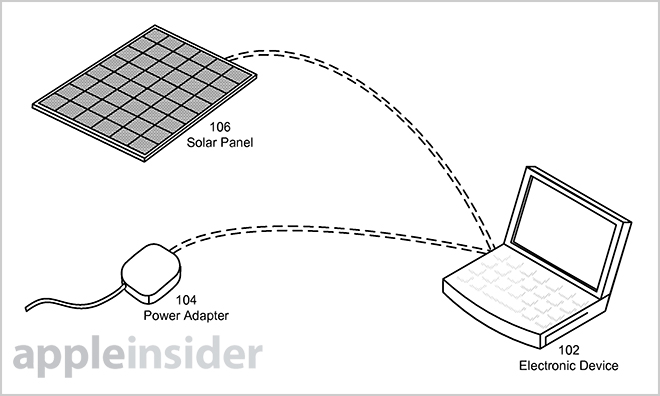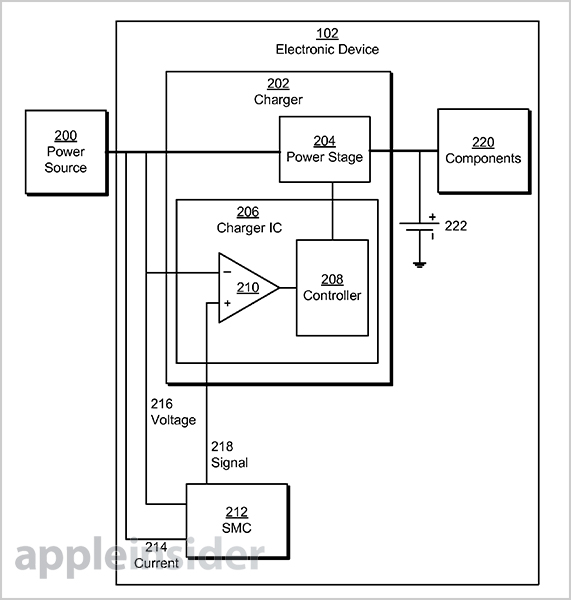The U.S. Patent and Trademark Office on Thursday published an Apple patent application for a unique solar-ready power management system that can be integrated into the company's portable product lineup, negating the need for bulky external converters.
Apple already has a number of solar power inventions to its name, but Thursday's filing is one of the first to propose a solution that can be made viable in the near term.
As noted in the patent, titled "Power management systems for accepting adapter and solar power in electronic devices," Apple is not looking to invent a completely new solar power solution, as it has done in the past. Instead, the proposed method would take advantage of existing technologies and, more importantly, can be produced with currently available components.
As electronics become more powerful with each successive generation, they in turn require more power, which for portables is limited by battery capacities. Apple notes these devices are therefore dependent on availability of mains electricity, or a wall outlet.
There are solutions, such as solar panels, that can add extra juice on the go, but existing tech relies on external circuits to convert solar panel power to a form compatible with electronic devices. More specifically, iPhones and MacBooks accept specific direct current (DC) voltages. While an option, integrated solar panels have proven bulky and the aesthetics may be less than desirable for Apple.
According to the filing, the integrated power management system would include a system micro controller (SMC) and a charger. Power would flow to the system from either an AC-to-DC adapter or directly from a photovoltaic solar panel's output, which is DC only, then be measured and converted to the necessary voltage.
In this embodiment, charger's power stage incorporates what is known as a buck converter, or step-down DC-to-DC converter. Incoming power is monitored by a charger IC, converted to an appropriate voltage and fed into either an input current loop, a battery current loop, an output voltage loop, or an input voltage loop to control charging.
The SMC monitors system power metrics like battery charge, health and input power type, among others, and manages the power stage accordingly.
In the case of solar power input, the SMC would track a maximum power point for the panels by any number of methods, including multiplying current with voltage. Once this point is established, SMC sends a signal to the charger IC, which uses the data to adjust a reference voltage for maximum power point tracking (MPPT). This point determines what voltage changes need to be applied to the solar panel input.
Finally, Apple notes that the power management system can accept both solar and mains power simultaneously.
Illustration of power management system with incorporated MPPT.All processing and adjustments can be accomplished with established techniques and deployed in a reasonably small component package, making the invention suitable for use in iPhones and MacBooks. While solar tech is somewhat of a rarity, the alternative energy solution is becoming more popular with mainstream consumers looking for on-the-go power.
Apple's solar power converter patent application was first filed for in 2012 and credits Kisun Lee, Manisha P. Pandya and Shimon Elkayam as its inventors.
 Mikey Campbell
Mikey Campbell





-xl-m.jpg)


-m.jpg)






 Wesley Hilliard
Wesley Hilliard
 Christine McKee
Christine McKee
 Amber Neely
Amber Neely
 William Gallagher
William Gallagher
 Malcolm Owen
Malcolm Owen

 Mike Wuerthele
Mike Wuerthele









7 Comments
I'm sorry, but I don't see anything patentable here. The voltage and power control circuitry is pretty textbook.
It looks like that are patenting a method to allow both a solar cell input as well as the standard AC/DC converter. Solar cell put out power differently then a wall adapter so the system would need to know how to deal with that on the fly.
Just more proof they are building a solar powered car.
[quote name="boriscleto" url="/t/160503/apple-investigating-built-in-solar-power-converters-for-iphone-macbook#post_2427915"]Just more proof they are building a solar powered car.[/quote] That can fly... :D
Not sure this is a particularly practical approach.
As of today, all you need to charge a laptop with a solar panel is a car-12V-to-magsafe adapter and off you go. Doesn't matter what solar panel you have after that, as long as it can output at least 12V. The car to magsafe adapters are fairly small by now and pretty damn cheap, too.
In the future, if you didn't have a magsafe ready solar panel, you'd need an adapter from whatever socket the panel uses to whatever socket Apple uses. Chances are, the cable would be proprietary and cost more than the old car to magsafe connector.
I think I'll happily stick with what I have now.